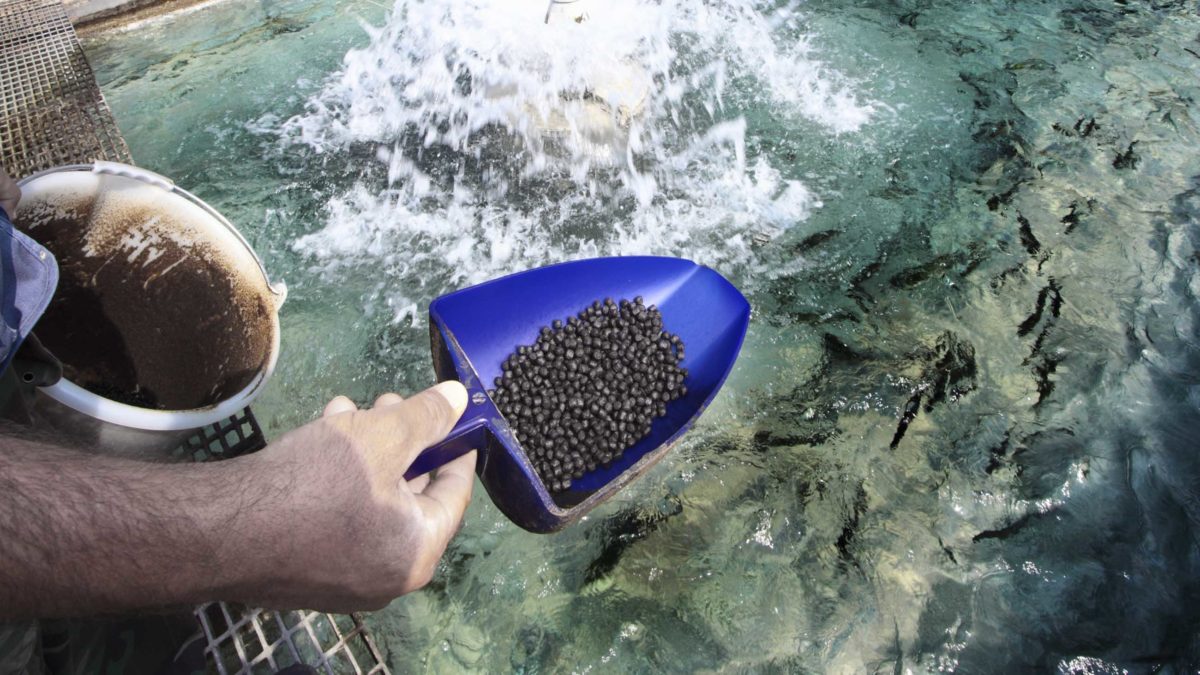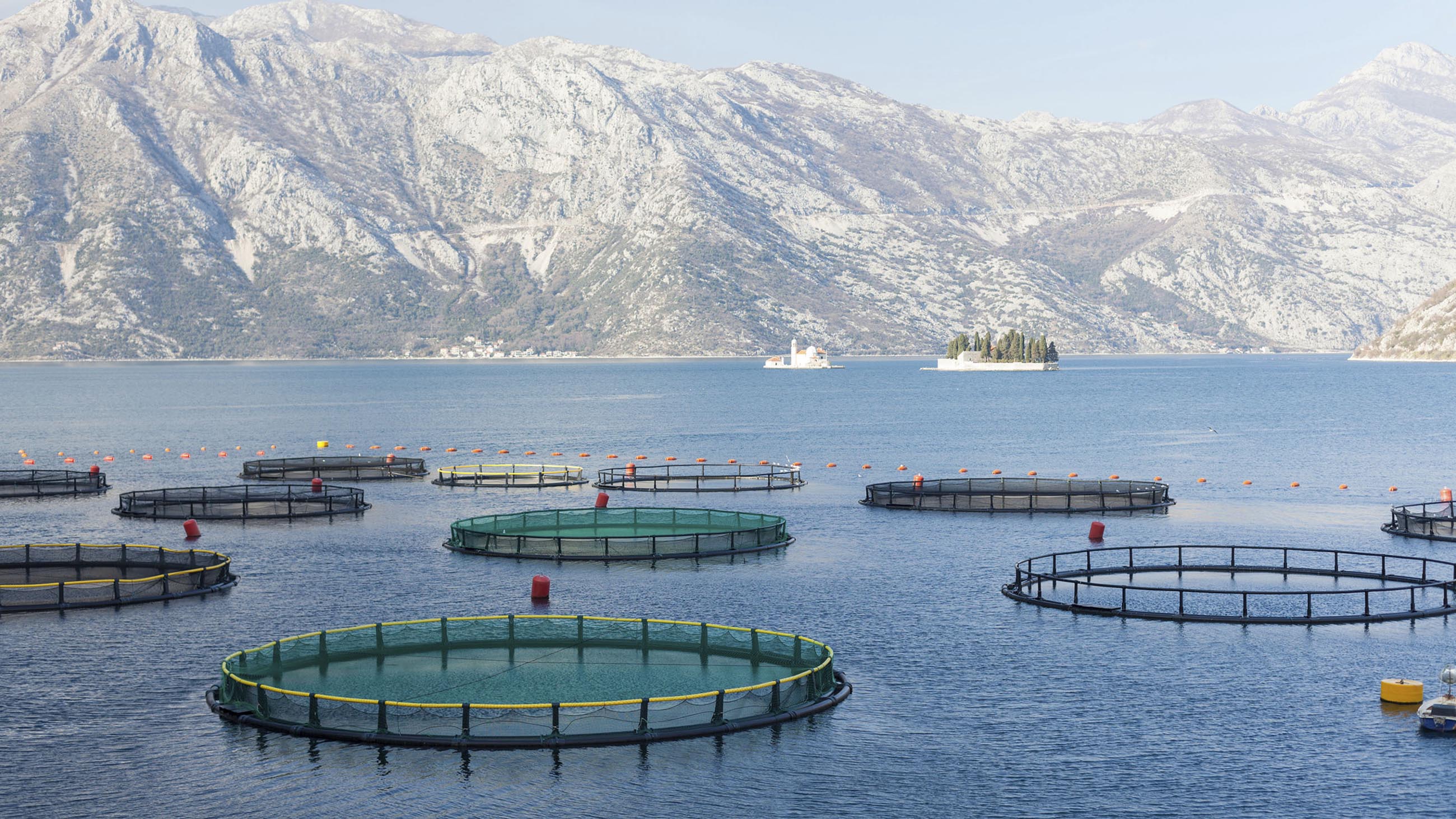Wanted: Fish Food That Isn’t Fish
Humans are eating more fish than ever. And since 2014, most of what we eat has come not from the wild, but from fish farms operated by the fast-growing aquaculture industry. But what do these farmed fish eat?
The answer is just as unappetizing as it sounds — and just as worrisome to advocates of sustainable seafood. The typical fish-farm diet (“aquafeed,” in industry parlance) contains fish — specifically fish meal and fish oil, made largely from wild-caught “forage” fish. And because stocks of wild fish are declining, that poses a serious long-term problem for the world food supply.
Wild fish are a critical food source for larger fish and other marine life, to say nothing of humans. Relying on them to provide fish feed for aquaculture is fundamentally unsustainable. As Kevin Fitzsimmons, an environmental science professor at the University of Arizona and a former president of the World Aquaculture Society, puts it, “Many forage fisheries around the world are collapsing.”
So Fitzsimmons and some like-minded scientists and environmental advocates — along with the Monterey Bay Aquarium, the New England Aquarium, and others — have come up with a new way to encourage the multibillion-dollar industry to develop alternative diets for farmed fish: the F3 Fish-Free Feed Challenge, a contest for feed makers and ingredient developers. The goal is to create commercially viable products that don’t use any fish ingredients.
Sixteen companies around the world have registered, including startups in the United States and behemoths in Asia, which accounts for about 89 percent of the farmed fish people eat, according to a report from the United Nations Food and Agriculture Organization. The organizers are urging additional companies to partner with registrants by September 30, when an analysis and ingredient list are also due. The first company to sell 100,000 metric tons of fish-free feed by September 15, 2017 (or the company that sells the most, if nobody reaches that amount), will win at least $200,000. (Donations for the prize are still being accepted.)

The marine ecosystem matters to food security and “we’re damaging it,” one scientist said.
Visual: iStock.com
The F3 contest is an unusual, timely approach, said Rick Barrows, a fish nutritionist who retired this month from the Agricultural Research Service in the United States Department of Agriculture and is consulting for the contest, feed companies, and others within the industry. “Rather than using a stick, it’s actually providing a carrot,” he said, adding that there’s a “worldwide effort to develop new feed ingredients” to provide the needed nutrients using soybeans, black soldier flies, and microalgae, among many other sources. The contest, funded primarily by individuals pledging small amounts, is “sending shock waves through the industry,” Barrows explained, because it sends a signal that consumers are paying more attention to what farmed fish eat.
Of course, most consumers aren’t concerned about the diet of the tilapia fillet they ate last night. But Randy Brummett, a fish biologist with the World Bank, which contributed to the contest’s prize, says they should be. The marine ecosystem matters to food security and “we’re damaging it,” Brummett said. Using some wild fish in feed is “justifiable” when sourced from well-managed fisheries and employed efficiently, he explained, but “the fact is, if we want to grow more fish in farms to take pressure off the oceans, the industry can’t increase its production on the existing supply. There just isn’t any more.”
The F3 contest isn’t without critics. In a position paper published in October 2015, the marine ingredients trade association IFFO wrote, “The industry accepts [that] other raw materials are needed to allow the continued growth of aquaculture,” but “it is surprising that a campaign to encourage the necessary development of additional feed ingredients has been launched under such a negative banner. Removing certified fishmeal from feed formulations not only disincentivizes fishmeal producers to make further improvements but potentially removes a market for byproducts that would otherwise be dumped.” In an email, the IFFO said it hadn’t changed its position.
The F3 organizers say that they support the industry’s efforts to minimize its use of wild fish, including the use of byproducts, but that for the purposes of the contest they need to be fish-free. “From an analytical basis, all we could do is say fish is there or not there,” Fitzsimmons explained. Wendy Norden, the science director for the Monterey Bay Aquarium’s Seafood Watch program, who is serving as one of F3’s judges, says the contest isn’t suggesting that feed makers completely stop using wild fish, just that they explore other options. “Industry, NGOs — we actually all want the same thing,” she said. “We want things to be sustainable. It’s good for business; it’s good for the environment.”
Fitzsimmons said other options could lead to a niche market for specialty brands that promote their fish free-diets, just like producers that trumpet their lines of free-range chicken and grass-fed beef. “You want to do more for the environment and you still want a high-quality product, you ask for this,” he said.
That’s been the case for one contest participant, TwoXSea, a seafood wholesaler based in San Francisco that started developing the first fish-free feed for commercially farmed trout in the U.S. in 2009. TwoXSea now sells about 200,000 pounds of its vegetarian trout to roughly 150 restaurants each year, according to co-owner Kenny Belov, who says chefs are “thrilled” when they taste it and learn what conventional trout feed contains. TwoXSea’s attempt to sell tilapia raised on a similar diet wasn’t as successful, even though its flavor and texture were a hit: Diners “were not willing to spend the money,” Belov said, adding that he’s working on reducing the cost.
Belov is against using farmed fish to replace wild catches from well-managed fisheries. TwoXSea doesn’t carry farmed salmon, for example, instead sourcing wild salmon when it’s in season. “I don’t want to create something that puts an entire group of individuals out of work,” he said. “There is no commercial trout fishery in this country. Any piece of trout you buy is farmed.” By farming trout without using forage fish, “we’ve created something that’s good for future generations.”
.
But developing fish-free feed hinges on understanding that the right balance of specific nutrients matters to the healthy growth of the fish, not specific ingredients they’d find in the wild, according to Barrows, who started helping TwoXSea make its feed in 2009 and has created alternative diets for multiple species. “Rather than try to reduce fish meal, which is what everybody had been working on, we tried to totally eliminate it.” Replacing fish oil was (and is) harder, because the few alternatives were (and are) expensive, he said, describing an affordable fish oil replacement as the “holy grail” of ingredient development.
The next step is getting more fish farms to try alternative feeds. Brummett says the biggest hurdle after price is aversion to risk: Farmers “have a formula that works and they don’t want to tinker with it.” The World Bank is “toying with the possibility” of providing guarantees to farmers in developing countries to reduce their risk. For example, he said, if farmers’ production decreased by 5 percent after using a new formulation, the World Bank would reimburse them for the loss or split it with them. “Fish meal and fish oil prices are going up and up,” Brummett said. “There’s no reason not to try alternatives now.”
Farmers have been steadily adopting the Australian feed maker Ridley’s first alternative aquafeed, which it launched last year for prawn production, according to Sunil Kadri, the company’s head of sales and business development. The new feed is the result of about a decade of research and development to minimize the use of wild fish, and he expects the company to sell 5,000 metric tons of it this year, up from about 3,000 in 2015, a significant share of the 50,000 metric tons of the aquafeed it sells annually. Customers “get the same performance at the same price,” he said.
Kadri, who researched fish behavior while earning his doctorate in zoology, acknowledges that the current version doesn’t meet the contest’s criteria because it uses byproducts from processing fish, an increasingly popular practice within the industry. But the new formula Ridley plans to start selling this year won’t contain any fish, he said. Next year, it will introduce fish-free versions for other types of farmed fish, including salmon and barramundi, he added. “It’s the way of the future for sustainable seafood supply.”
Nick Leiber is a Madrid-based freelance journalist. He has written for Bloomberg Businessweek, Bloomberg News, and The New York Times, among other publications.
This article has been updated to clarify that feeds include fish products, among others.











Comments are automatically closed one year after article publication. Archived comments are below.
The fishmeal and fish oil industry have embraced sustainability – over 40% of the global production is already certified as responsibly sourced. This far exceeds the sustainability claims of other feed ingredients. As the previous commentator mentioned, the aquaculture industry has been growing just fine by using the same quantity of fishmeal and fish oil to make more and more feed so dressing this up as a problem of sustainability or of restricting the feed industry is just wrong. The real problem is finding new feed ingredients AS WELL AS fishmeal and fish oil, not instead of.
If you look at fish meal production over time, it has been flat (constant) for about 40 years while aquaculture has grown 10 times to the largest, user while chickens and pigs have used less. With no correlation between fish meal production and aquaculture, where is the case of a problem. Since when do market shifts say something about the environment? It is all activist fundraising that created this imaginary link between fish meal and aquaculture (it is simple minded enough to sell well).
All animal diets are really formulated by competing linear programming models. Rick Barrows has created vegan diets that outperformed fish meal control diets with marine carnivorous fish, but they are more expensive. It is just economics. Fish meal is lower cost than things like corn gluten meal, that are interchangeable in the diets.